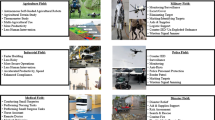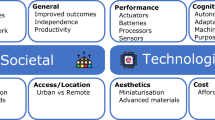Abstract
Finland is ranked rather high in international robot density statistics. In Finland, robots are typically used in applications where they operate in close proximity to humans. The research described in this paper, sourced from Finnish databases, identified 25 severe accidents which can be attributed to robots. The current accident data can provide an insight into the type of accidents associated with future human-robot interaction (HRI) applications. Accident statistics indicate that most of the severe robot-related accidents involved crushing a person against a rigid object. As crushing hazards currently dominate accident statistics, and with HRI applications becoming increasingly common, humans are expected to be exposed to more crushing hazards in the future. The close proximity of the robots means that there is very little time to escape from crushing hazard. The prevention of collisions between robots and humans is paramount to reducing the amount of accidents. Actions to diminish the effects of any subsequent collision are also important. The control after a collision, however, needs to be very quick in order to minimise the damage caused by an impact. Current practice demands that upon detection of a collision, active movements are typically not allowed without a human supervision. Moving a robot away to a safe position and releasing any pressure against a person may save lives, but would entail some adjustments or new interpretations of the current safety requirements.
Similar content being viewed by others
References
ABB Application Manual (2004–2008) Motion coordination and supervision RobotWare 5.0 document ID: 3HAC18154-1 revision: F ABB
Accident Report Database of Safety Administration (TAPS) of Finland (2009) In Finnish. https://eportti.tietopalvelut.com/taps/TapsFrame_alku.asp (accessed 29.7.2009)
Alvarado ML (2002) A risk assessment of human-robot interface operations to control the potential of injuries/losses at the xyz manufacturing company. The Graduate College University of Wisconsin-Stout, May 2002
EN ISO 10218-1 (2006) Robots for industrial environment—safety requirements—part 1: robot. CEN, 30 p
EN 60204-1 (2006) Safety of machinery. Electrical equipment of machines. Part 1: general requirements. CEN. 216 p
Federation of Accident Insurance Institutions. http://www.tvl.fi/
Haddadin S, Albu-Schäffer A (2010) Physical human robot interaction: dependability and safety. Videos related to tests. http://www.phriends.eu/videos.htm (accessed 8.1.2010)
Haddadin S, Albu-Schäffer A, Strohmayr M, Frommberger M, Hirzinger G (2008) Injury evaluation of human-robot impacts. In: IEEE international conference on robotics and automation, Pasadena, CA, USA, May 19–23, 2008, pp 2203–2204
Haddadin S, Albu-Schäffer A, Frommberger M, Hirzinger G (2008) The role of the robot mass and velocity in physical human-robot interaction—part II: constrained blunt impacts. In: IEEE international conference on robotics and automation, Pasadena, CA, USA, May 19–23, 2008
Hollnagel E, Woods DD, Leveson N (eds) (2006) Resilience engineering. Concepts and precepts. Ashgate Publishing, Hampshire
ISO/DIS 10218-2 (2008) Draft standard. Robots for industrial environment—safety requirements—part 2: robot system and integration. ISO, 94 p
Karwowski W, Järvinen J, Rahimi M (1994) Human aspects of industrial robotics. In: Salvendy G, Karwowski W (eds) Design of work and development of personnel in advanced manufacturing. Wiley, New York, pp 493–534
Klez TA (2003) Inherently safer design—its scope and future. Trans IChemE, 81 part B, pp 401–405
Kuivanen R (1995) Methodology for simultaneous robot system safety design. VTT publications 219, 142 p + app 13 p
Malm T (ed) (2008) Safety of collaborating robotics. In Finnish. Robotics society of Finland, 116 p + att 72 p
Malm T, Toivonen S, Laine E (2007) Safety issues related to industrial robots collaborating with humans. In: Safety of industrial automated systems (SIAS2007), Tokyo, Japan, pp 216–221
Robotics Society of Finland (2008) Industrial robot statistics in Finland 2007. In Finnish, 3 p. http://www.roboyhd.fi/ (accessed 8.1.2010)
The IFR Statistical Department, study World Robotics. http://www.worldrobotics.org/downloads/2008_Pressinfo_english.pdf (accessed 10.3.2010)
Author information
Authors and Affiliations
Corresponding author
Rights and permissions
About this article
Cite this article
Malm, T., Viitaniemi, J., Latokartano, J. et al. Safety of Interactive Robotics—Learning from Accidents. Int J of Soc Robotics 2, 221–227 (2010). https://doi.org/10.1007/s12369-010-0057-8
Accepted:
Published:
Issue Date:
DOI: https://doi.org/10.1007/s12369-010-0057-8




